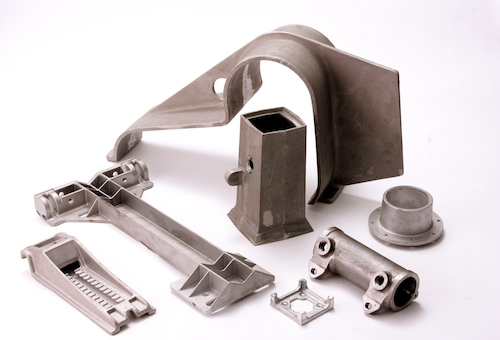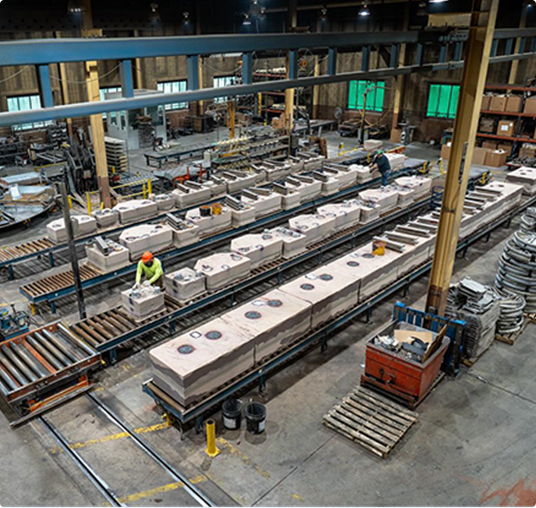Discovering the Perks and Practical Use Aluminum Castings in Today's Market
Aluminum spreadings have actually become significantly relevant in numerous industries due to their unique attributes. Their light-weight nature and resistance to corrosion make them appropriate for demanding applications. In addition, the exceptional strength-to-weight ratio uses significant advantages in style and production. As markets remain to explore their potential, the complete scope of aluminum castings' benefits and applications stays to be totally discovered. What exists in advance for this versatile product?
The Lightweight Advantage of Light Weight Aluminum Castings
Numerous materials are made use of in manufacturing, light weight aluminum castings stand out mostly due to their light-weight residential properties. This characteristic makes light weight aluminum castings an eye-catching choice for numerous markets, especially in aerospace and automobile applications, where weight reduction is necessary for boosting fuel effectiveness and efficiency. The light-weight nature of aluminum enables suppliers to produce components that are easier to handle and mount, ultimately reducing labor expenses.
The capability to generate complex forms without substantial weight fines makes it possible for designers to introduce while preserving structural honesty. Light weight aluminum castings can properly change much heavier materials, causing substantial cost savings in shipping and functional expenses. Their light-weight benefit also adds to improved product longevity, as lighter parts frequently lead to reduced damage on equipment. Overall, the light-weight homes of light weight aluminum castings give suppliers with an one-upmanship, fostering advancements in product layout and efficiency across various industries.

Extraordinary Rust Resistance
Aluminum castings have an all-natural resistance to oxidation, which substantially improves their durability in numerous atmospheres. This intrinsic property not just adds to their resilience however additionally straightens with the lightweight benefit that aluminum supplies. Therefore, light weight aluminum spreadings are progressively recognized for their phenomenal deterioration resistance in many applications.

Normally Resistant to Oxidation
One of the standout qualities of light weight aluminum spreadings is their remarkable deterioration resistance, which originates from a natural oxidation process. When exposed to air, light weight aluminum reacts to develop a thin, safety layer of light weight aluminum oxide. This layer functions as an obstacle against additional oxidation and safeguards the underlying steel from corrosive aspects such as wetness and salts. Unlike other steels, this oxide layer is self-repairing; if harmed, it quickly reforms when subjected to air. This special building enhances the durability of aluminum spreadings in numerous settings, making them suitable for applications in sectors such as aerospace, automobile, and marine. Subsequently, the all-natural resistance to oxidation significantly minimizes maintenance costs and increases the dependability of light weight aluminum castings sought after conditions.
Light-weight Longevity Advantage
The light-weight nature of light weight aluminum castings contributes significantly to their durability, making them a useful selection in various markets. This phenomenal resilience is greatly credited to aluminum's natural resistance to corrosion, which is improved additionally with anodizing and other surface area therapies. Unlike many metals, light weight aluminum does not rust; instead, it forms a protective oxide layer that shields it from ecological damages. This residential or commercial property is particularly beneficial in sectors such as automobile and aerospace, where weight reduction is important without jeopardizing stamina. In addition, the durability of light weight aluminum castings minimizes upkeep expenses and replacements, providing economic advantages with time. Subsequently, their light-weight resilience and corrosion resistance setting aluminum spreadings as a remarkable material for contemporary manufacturing applications.
Superior Strength-to-Weight Proportion
An impressive feature of aluminum spreadings is their remarkable strength-to-weight proportion, which makes them extremely desirable in numerous applications. This inherent residential property enables light weight aluminum castings to stand up to significant tension while staying lightweight, a vital factor in industries such as aerospace, automobile, and production. Designers usually choose light weight aluminum castings for elements that call for both toughness and minimized weight, improving fuel efficiency and performance.
The high strength-to-weight proportion also facilitates the style of elaborate shapes and structures, making aluminum spreadings flexible for complex applications. Additionally, the capability to preserve architectural stability under difficult conditions warranties longevity and dependability in items, from airplane structures to automobile components. This advantage contributes to the growing fad of making use of light weight aluminum castings in cutting-edge layouts, inevitably bring about boosted performance and efficiency throughout diverse markets. Consequently, the remarkable strength-to-weight proportion of aluminum spreadings places them as a crucial material in contemporary design and production.
Cost-Effectiveness in Manufacturing
Cost-effectiveness in light weight aluminum spreading production is mostly achieved with minimized product waste and effective production procedures. By optimizing designs and utilizing advanced strategies, producers can lessen excess material use while keeping quality criteria. This method not just decreases production costs but also contributes to much more sustainable methods within the industry.
Reduced Material Waste
Lowering product waste in light weight aluminum spreading processes substantially improves production performance. By maximizing the design and production methods, business can decrease excess scrap and enhance resource application. This decrease in waste not only decreases material expenses yet also adds to explanation a more sustainable manufacturing model. The ability to recycle aluminum additional assistances cost-effectiveness, allowing suppliers to reclaim and reuse products without endangering high quality. As the sector significantly concentrates on sustainability, decreased product waste aligns with ecological objectives while at the same time enhancing earnings. Inevitably, effective use resources enhances the competitive position of businesses on the market, making light weight aluminum spreadings a favorable choice in numerous applications. The strategic method to minimizing waste reflects a dedication to both financial and environmental responsibility.
Effective Manufacturing Processes
While typical manufacturing processes can incur substantial expenses, light weight aluminum spreading supplies a much more reliable option that improves total production profitability. This method minimizes material waste and enables for precise control over the manufacturing process, causing minimized labor and functional prices. The capacity to generate intricate shapes with fewer actions even more streamlines manufacturing, adding to shorter preparations. Additionally, aluminum's light-weight nature and outstanding thermal conductivity enable for power cost savings throughout manufacturing and in the final application. By using modern-day spreading modern technologies, makers can attain higher throughput without sacrificing high quality. Aluminum casting stands out as an affordable option, making it an eye-catching option for businesses intending to optimize their production processes in today's affordable market.
Adaptability Throughout Industries
Aluminum castings show amazing adaptability throughout numerous markets, as they can be customized to satisfy particular demands and applications. In the vehicle sector, light weight aluminum spreadings are utilized in engine blocks, transmission real estates, and wheels, using light-weight yet durable solutions that enhance fuel effectiveness. The aerospace industry likewise benefits from light weight aluminum castings, utilizing them in architectural parts and engine parts as a result of their strength-to-weight proportion.
In the customer items industry, makers employ light weight aluminum spreadings for products ranging from cooking equipment to furniture, offering both visual allure and capability. The electronic devices industry uses aluminum spreadings for real estates and heat sinks, making certain efficient thermal management. In addition, the building field leverages light weight aluminum spreadings for building elements and architectural parts, enhancing longevity and design versatility. This broad applicability highlights light weight aluminum castings as a necessary source, satisfying the varied demands of various markets while keeping high efficiency and integrity.
Sustainability and Environmental Impact
As sectors progressively prioritize sustainable techniques, aluminum castings become an environment-friendly selection due to their recyclability and low environmental footprint. Light weight aluminum is among the most recycled materials worldwide, with the ability to be repurposed several times without destruction of quality. This particular substantially reduces the demand for raw products and energy usage associated with key aluminum manufacturing, which is energy-intensive.
Furthermore, aluminum spreadings add to lightweight designs, resulting in sustain effectiveness in transport applications such as aerospace and automotive markets. Their toughness and resistance to rust expand item life expectancies, better lessening waste and resource usage over time. Moreover, lots of suppliers are taking on responsible sourcing and eco-friendly manufacturing approaches, enhancing the sustainability of aluminum spreading processes. read here Generally, light weight aluminum spreadings represent a sensible solution for businesses intending to minimize their environmental influence while accomplishing efficiency and effectiveness.
Advancements in Aluminum Spreading Technologies
Recent advancements in light weight aluminum spreading innovations have actually substantially improved the effectiveness and top quality of manufacturing processes. Innovations such as 3D printing and progressed mold-making strategies have enabled suppliers to create complex layouts with reduced product waste. This change not just boosts the accuracy of cast elements but additionally shortens lead times, permitting for rapid prototyping and faster market entrance.
The consolidation of advanced computer simulations help in anticipating possible flaws during casting, leading to higher-quality outcomes. Making use of light-weight alloys has likewise added to the growth of stronger, much more resilient items, providing to industries ranging from automobile to aerospace
Furthermore, automated spreading processes have emerged, decreasing human mistake and raising production speed. Jointly, these innovations are changing the aluminum spreading landscape, driving better competitiveness and sustainability in manufacturing. As markets remain to progress, these innovations will certainly play a necessary duty in meeting future needs for efficiency and top quality.
Often Asked Concerns
Just How Do Light Weight Aluminum Castings Compare to Various Other Metals in Regards To Thermal Conductivity?
Aluminum castings exhibit remarkable thermal conductivity contrasted to several metals, such as steel and iron - Aluminum Castings. Their lightweight nature and efficient warmth distribution make them perfect for applications requiring reliable thermal administration in different sectors
What Are the Usual Issues Found in Aluminum Castings?
Common problems in light weight aluminum spreadings include porosity, shrinking, incorporations, and surface abnormalities. These concerns typically occur from incorrect air conditioning prices, poor mold style, or contaminations, influencing the overall high quality and performance of the last product.
Can Aluminum Castings Be Recycled, and Just how?
Aluminum spreadings can be reused properly. The process involves collecting, melting, and reforming the aluminum, which reduces waste and preserves sources. This reusing adds to sustainability while keeping the material's buildings for future usage.
What Are the Normal Lead Times for Aluminum Spreading Production?
Normally, preparations for aluminum casting production array from 2 to 6 weeks, depending upon variables such as complexity, tooling demands, and production volume. Efficiency can enhance with recognized distributor partnerships and maximized manufacturing processes.
Just how Does the Surface End Up Affect Aluminum Spreading Performance?
The surface area coating markedly affects aluminum spreading performance by affecting rust resistance, aesthetic top quality, and friction features. A smoother finish boosts resilience and functionality, while a rougher appearance can enhance adhesion for subsequent coverings or therapies.
Lots of products are used in manufacturing, aluminum spreadings stand out mostly due to their lightweight residential or commercial properties. When subjected to air, aluminum responds to form a thin, protective layer of light weight Click This Link aluminum oxide. Cost-effectiveness in light weight aluminum spreading manufacturing is largely accomplished through reduced material waste and efficient manufacturing processes. Lowering product waste in aluminum spreading procedures considerably enhances manufacturing effectiveness. Ultimately, effective usage of raw products reinforces the affordable placement of organizations in the market, making light weight aluminum spreadings a favorable alternative in various applications.